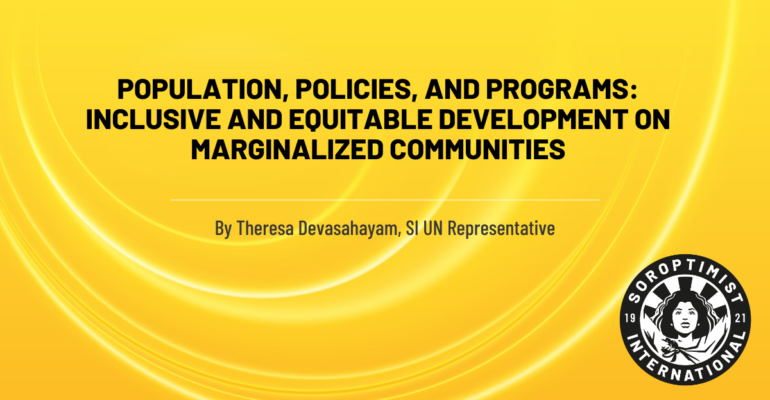Blog of Theresa Devasahayam, SI UN Representative in Bangkok
Home to 36 countries, the Asia Pacific region contains 60 percent of the world’s population or 4.5 billion people. Marked by great population variation, the region’s current median age is 31 while its average life expectancy is 75 years – demographic trends which have implications for its economic development trajectory.
In the past ten years (2012-2022), the Asia Pacific has accounted for 66 percent of global GDP growth. Recent decades have seen socioeconomic advancement in the areas of education, health, nutrition, poverty eradication and sanitation. But since 2020, the pandemic has stifled economic progress.

The Seventh Asian and Pacific Population Conference
Generally, governments keep track of population trends of their countries to inform policy responses and meet the current needs of the citizenry. The Seventh Asian and Pacific Population Conference (APPC), organised by the United Nations Economic and Social Commission for Asia and the Pacific (UNESCAP) in collaboration with the United Nations Population Fund (UNFPA) in Asia and the Pacific, examines how the interrelationships between population, resources, the environment, and social and economic development are recognised and managed.
Held from 15 to 17 November 2023, the Conference convenes every ten years. A range of themes were discussed at the Conference, including population ageing, low fertility and increased human mobility. Additionally, the impacts of climate change, disasters and conflicts were deliberated upon, with specific reference to migration. Emergent issues such as digital transformation were also touched upon.
Points of Discussion
The meeting also reviewed the outcomes of the Sixth APPC, from which the Ministerial Declaration identified a range of priority actions, addressing population-related challenges. These priority actions include: poverty eradication and employment; health; education; gender equality and women’s empowerment; adolescents and young people; ageing; international migration; urbanisation; internal migration; population and sustainable development; and data and statistics; as well as modalities for implementation at the global, regional and national levels. It was raised that since 2013 a small, incremental progress has been recorded in the countries in the Asia Pacific region only because governments and CSOs have played an active role to address the gaps in these above-mentioned areas.
Age and Affluence
Also discussed were how demographic changes in the region have evolved in spite of persistent socio-economic inequalities and vulnerabilities. For example, in the Asia Pacific region, countries are ageing much faster than they are getting richer, particularly in comparison to countries in the West.
This relationship between age and affluence in the Asia Pacific is seen in a negative light for another reason – a population trend placing demands on the younger generation to provide for the older generation, as captured in the concept of the old-age dependency ratio. In ageing societies, costs channelled to the older population have been found to be three times more than those channelled to children. Considering that children are the lifeline of the future, investing in them to maximize the potential of every child remains an important and urgent intervention, especially in ageing countries.

Inclusive Development
To bring all individuals into the development process, it is paramount that policies are inclusive, meaningful and not tokenistic. For true development to occur inclusivity should ensure that no individual or social group is left behind: women, older persons, persons with disability, persons of varied sexual orientation, migrants/refugees, ethnic and religious minorities, and the poor. Children are no exception since they, too, are susceptible to exploitation.
However, inclusive development should not only be about ensuring the meaningful participation of these groups, but rather treating their participation as a right. To be certain that policies and programs are inclusive: an intersectional approach is crucial. Summarily, this approach refers to people’s overlapping social identities which capture an amalgam of discriminatory experiences rather than one kind of discrimination at one point of time. When Discussing inclusion and equity, policies and programs cannot be gender, age, ability, sexuality, and minority neutral; rather, the rights of every individual, regardless of background, should be central to the development agenda.
Inclusivity is also possible through universal coverage since this approach to development ensures that no individual or group is left behind. The success of universal coverage has been demonstrated in programs related to health, education and social protections. Ensuring inclusivity involves different players: Civil Society Organisations (CSOs), the private sector and governments. In this respect, commitments should be accompanied with concrete actions and corresponding budgetary processes.
Recommendations for CSOs
As a CSO, the work of Soroptimist International (SI), particularly concerning education and training projects, is vital for empowering women and girls. To ensure our work remains effective, club projects should adopt a wholly inclusive approach at two levels: on the advocacy front and also at the service front. For instance, at the advocacy front, creating dialogue with country governments, holding them accountable to the conventions they have ratified and, in turn, uphold the rights, well-being, and aspirations of every individual; and, at the service front, as they help communities through the various projects they engage in.

